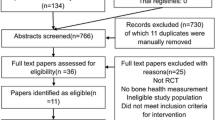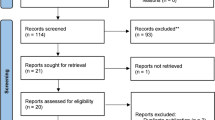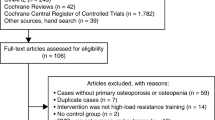Abstract
Introduction
Tai chi may have beneficial effects with respect to balance, falls and non-vertebral fractures. The purpose of this systematic review was to evaluate evidence from controlled clinical trials testing the effectiveness of tai chi for osteoporosis.
Methods
Systematic searches were conducted on 20 electronic databases. The outcome measures considered for inclusion were changes in bone parameters.
Results
Five randomized clinical trials (RCTs) and two controlled clinical trials (CCT) met all inclusion criteria. In postmenopausal women, one RCT found tai chi to be superior for loss of bone mineral density (BMD) compared with sedentary lifestyle, while two other RCTs found no differences between tai chi and exercises or calcium supplementation for BMD. The meta-analysis showed no significant effect of tai chi on BMD change at the spine compared with no treatment in postmenopausal women. One RCT failed to show favorable effects of tai chi compared with resistance training (RT) for total hip BMD in elderly women. A further RCT compared tai chi with RT on bone metabolism and reported favorable effects compared with RT in the elderly.
Conclusion
The evidence for tai chi in the prevention or treatment of osteoporosis is not convincing. More rigorous research seems warranted.


Similar content being viewed by others
References
Center for Disease Control and Prevention (2006) Osteoporosis. In. pp (available at: http://www.cdc.gov/nchs/data/nhanes/databriefs/osteoporosis.pdf) Accessibility verified 19 June, 2007
WHO Scientific Group on the Prevention and Management of Osteoporosis (2003) Prevention and management of osteoporosis: report of a WHO scientific group (2000: Geneva, Switzerland). World Health Orgarnization, Geneva
U.S. Department of Health and Human Service (2004) Bone health and osteoporosis: a report of the surgeon general. U.S. Department of Health and Human Service, Office of the Surgeon General, Rockville, MD
Asikainen TM, Kukkonen-Harjula K, Miilunpalo S (2004) Exercise for health for early postmenopausal women: a systematic review of randomised controlled trials. Sports Med 34:753–778
Bonaiuti D, Shea B, Iovine R, Negrini S, Robinson V, Kemper HC, Wells G, Tugwell P, Cranney A (2002) Exercise for preventing and treating osteoporosis in postmenopausal women. Cochrane Database of Systematic Reviews Art. No.: CD000333. DOI 000310.001002/14651858.CD14000333
Henderson NK, White CP, Eisman JA (1998) The roles of exercise and fall risk reduction in the prevention of osteoporosis. Endocrinol Metab Clin North Am 27:369–387
National Center for Complementary and Alternative Medicine Tai chi for health purposes. In. pp (available at http://nccam.nih.gov/health/taichi/). Accessibility verified 02 June, 2007
Lock CA, Lecouturier J, Mason JM, Dickinson HO (2006) Lifestyle interventions to prevent osteoporotic fractures: a systematic review. Osteoporos Int 17:20–28
Lee MS, Pittler MH, Taylor-Piliae R, Edazd E (2007) Tai Chi for Cardiovascular Disease and Its Risk Factors: Systematic Review. J Hypertens 25:1974–1975
Li JX, Hong Y, Chan KM (2001) Tai chi: physiological characteristics and beneficial effects on health. Br J Sports Med 35:148–156
Wang C, Collet JP, Lau J (2004) The effect of Tai Chi on health outcomes in patients with chronic conditions: a systematic review. Arch Intern Med 164:493–501
Xuatian S, Sun F, Tai S (2006) Tai chi. In Yuan CS, Bieber EJ, Bauer BA (eds) Textbook of complementary and alternative medicine. Informa Healthcare, Oxon, UK
Gong M, Zhang SZ, Wang B, Wang DH (2003) [Effects of long-term shadowboxing exercise on bone mineral density in the aged]. Chin J Clin Rehab 7:2238–2239 (in Chinese)
Ock SM, Choi WS, Kim CM (2000) [Femoral and vertebral bone mineral density and physical fitness factors in postmenopausal women of practicing tai chi]. J Korean Acad Fam Med 21:46–56(in Korean)
Qin L, Au S, Choy W, Leung P, Neff M, Lee K, Lau M, Woo J, Chan K (2002) Regular Tai Chi Chuan exercise may retard bone loss in postmenopausal women: A case-control study. Arch Phys Med Rehabil 83:1355–1359
Qin L, Choy W, Leung K, Leung PC, Au S, Hung W, Dambacher M, Chan K (2005) Beneficial effects of regular Tai Chi exercise on musculoskeletal system. J Bone Miner Metab 23:186–190
Jadad AR, Moore RA, Carroll D, Jenkinson C, Reynolds DJ, Gavaghan DJ, McQuay HJ (1996) Assessing the quality of reports of randomized clinical trials: is blinding necessary? Control Clin Trials 17:1–12
Chan K, Qin L, Lau M, Woo J, Au S, Choy W, Lee K, Lee S (2004) A randomized, prospective study of the effects of Tai Chi Chun exercise on bone mineral density in postmenopausal women. Arch Phys Med Rehabil 85:717–722
Shen CL, Williams JS, Chyu MC, Paige RL, Stephens AL, Chauncey KB, Prabhu FR, Ferris LT, Yeh JK (2007) Comparison of the effects of tai chi and resistance training on bone metabolism in the elderly: a feasibility study. Am J Chin Med 35:369–381
Woo J, Hong A, Lau E, Lynn H (2007) A randomised controlled trial of Tai Chi and resistance exercise on bone health, muscle strength and balance in community-living elderly people. Age Ageing 36:262–268
Zhou Y (2004) [Effect of traditional sports on bone density of menopause women]. J Beijing Sport Univ 27:354–335, 360 (in Chinese)
Zhou Y, Lee J, Chen YB, Gu JY (2005) [Effect of tai chi pushing hand exercise and calcium supplement on bone mineral density of menopausal women]. Chin J Sports Med 24:106–108 (in Chinese)
Kim H, Lim J (2006) Effect of 6 month tai chi exercise program on physical health, bone mineral density and fracture risk in institutionalized elderly. In The 1st international conference of tai chi for health. Seoul, South Korea, p 170
Xu DH, Lawson D, Kras A (2004) A study on tai ji exercise and traditional Chinese medical modalities in relation to bone structure, bone function and menopausal symptomsq. J Chin Med 74:10–14
Maciaszek J, Osinski W, Szeklicki R, Stemplewski R (2007) Effect of tai chi on body balance: randomised controlled trial in men with osteopenia or osteoporosis. Am J Chin Med 35:1–9
Minne HW, on the behalf of the IOF Committee of Scientific Advisors http://www.iofbonehealth.org/publications/move-it-or-lose-it.html) Move it or Lose it: How exercise helps to build and maintain strong bones, prevent falls and fractures, and speed rehabilitation. Accessibility verified 21 August 2007
Pfeifer M, Minne HW, on the behalf of the IOF Committee of Scientific Advisors (avaiable at http://www.iofbonehealth.org/health-professionals/special-topics/exercise-recommendations.html) Bone loading exercise recommendations for prevention and treatment of osteoporosis. Accessibility verified 21 August 2007
Voukelatos A, Cumming RG, Lord SR, Rissel C (2007) A Randomized, Controlled Trial of tai chi for the Prevention of Falls: The Central Sydney tai chi Trial. J Am Geriatr Soc 55:1185–1191
Wolf SL, Barnhart HX, Kutner NG, McNeely E, Coogler C, Xu T (1996) Reducing frailty and falls in older persons: an investigation of Tai Chi and computerized balance training. Atlanta FICSIT Group. Frailty and Injuries: Cooperative Studies of Intervention Techniques. J Am Geriatr Soc 44:489–497
Geusens P, Autier P, Boonen S, Vanhoof J, Declerck K, Raus J (2002) The relationship among history of falls, osteoporosis, and fractures in postmenopausal women. Arch Phys Med Rehabil 83:903–906
Pfeifer M, Sinaki M, Geusens P, Boonen S, Preisinger E, Minne HW (2004) Musculoskeletal rehabilitation in osteoporosis: a review. J Bone Miner Res 19:1208–1214
Rossouw JE, Anderson GL, Prentice RL, LaCroix AZ, Kooperberg C, Stefanick ML, Jackson RD, Beresford SA, Howard BV, Johnson KC, Kotchen JM, Ockene J (2002) Risks and benefits of estrogen plus progestin in healthy postmenopausal women: principal results From the Women’s Health Initiative randomized controlled trial. JAMA 288:321–333
Wilson CJ, Datta SK (2001) Tai chi for the prevention of fractures in a nursing home population: an economic analysis. J Clin Outcomes Manage 8:19–27
Dickersin K (1990) The existence of publication bias and risk factors for its occurrence. JAMA 263:1385–1389
Egger M, Smith GD (1998) Bias in location and selection of studies. BMJ 316:61–66
Ernst E, Pittler MH (1997) Alternative therapy bias. Nature 385:480
Pittler MH, Abbot NC, Harkness EF, Ernst E (2000) Location bias in controlled clinical trials of complementary/alternative therapies. J Clin Epidemiol 53:485–489
Acknowledgements
The authors specially thank Kate Boddy for editing this manuscript.
Author information
Authors and Affiliations
Corresponding author
Additional information
Financial support: None
Rights and permissions
About this article
Cite this article
Lee, M.S., Pittler, M.H., Shin, BC. et al. Tai chi for osteoporosis: a systematic review. Osteoporos Int 19, 139–146 (2008). https://doi.org/10.1007/s00198-007-0486-x
Received:
Accepted:
Published:
Issue Date:
DOI: https://doi.org/10.1007/s00198-007-0486-x




